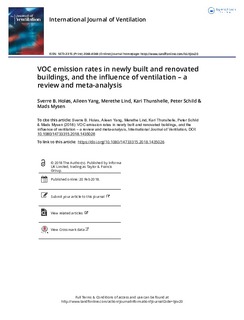| dc.contributor.author | Holøs, Sverre Bjørn | |
| dc.contributor.author | Yang, Aileen | |
| dc.contributor.author | Lind, Merethe | |
| dc.contributor.author | Thunshelle, Kari | |
| dc.contributor.author | Schild, Peter G. | |
| dc.contributor.author | Mysen, Mads | |
| dc.date.accessioned | 2018-03-06T16:35:39Z | |
| dc.date.available | 2018-03-06T16:35:39Z | |
| dc.date.created | 2018-02-21T07:27:47Z | |
| dc.date.issued | 2018 | |
| dc.identifier.citation | The International Journal of Ventilation. 2018, 1-14. | nb_NO |
| dc.identifier.issn | 1473-3315 | |
| dc.identifier.uri | http://hdl.handle.net/11250/2488994 | |
| dc.description.abstract | Few field studies have evaluated ventilation strategies, such as temporarily increasing the ventilation rate, to counter the high pollutant-load from off-gassing of volatile compounds from new materials in these buildings. We reviewed longitudinal studies that measured both ventilation rate (i.e. fresh air change rate) and airborne concentration of total volatile organic compounds (TVOC). Rates of emission of TVOC follow a multi-exponential decay trend over time after completion of a building. A tri-exponential trend-was fitted by quantile regression. Although the ventilation rate is key to controlling airborne concentrations, it does not noticeably influence TVOC emission rates. Specifying low-emitting materials, or bake-out before occupancy, both have a significant impact on emission rates . The results can be used to assess and size energy-efficient practical ventilation strategies (such as demand-controlled ventilation) to keep the concentration of TVOCs within acceptable levels during hours of occupancy after completion of a new or renovated building. | nb_NO |
| dc.description.sponsorship | This study is in part funded by the Research Council of Norway EnergiX program under Grant 255375/E20 | nb_NO |
| dc.language.iso | eng | nb_NO |
| dc.publisher | Taylor & Francis | nb_NO |
| dc.rights | Attribution-NonCommercial-NoDerivatives 4.0 Internasjonal | * |
| dc.rights.uri | http://creativecommons.org/licenses/by-nc-nd/4.0/deed.no | * |
| dc.subject | Indoor air quality | nb_NO |
| dc.subject | TVOC | nb_NO |
| dc.subject | Off-gassing | nb_NO |
| dc.subject | Emissions | nb_NO |
| dc.subject | New buildings | nb_NO |
| dc.subject | Renovation | nb_NO |
| dc.subject | Ventilation | nb_NO |
| dc.title | VOC emission rates in newly built and renovated buildings, and the influence of ventilation – a review and meta-analysis | nb_NO |
| dc.type | Journal article | nb_NO |
| dc.type | Peer reviewed | nb_NO |
| dc.description.version | publishedVersion | nb_NO |
| dc.rights.holder | © 2018 The Author(s). Published by Informa UK Limited, trading as Taylor & Francis Group. This is an Open Access article distributed under the terms of the Creative Commons Attribution-NonCommercial-NoDerivatives License (http://creativecommons.org/licenses/by-nc-nd/4.0/), which permits non-commercial re-use, distribution, and reproduction in any medium, provided the original work is properly cited, and is not altered, transformed, or built upon in any way. | nb_NO |
| dc.subject.nsi | VDP::Technology: 500 | nb_NO |
| dc.source.journal | The International Journal of Ventilation | nb_NO |
| dc.identifier.doi | 10.1080/14733315.2018.1435026 | |
| dc.identifier.cristin | 1567217 | |
| dc.relation.project | Norges forskningsråd: 255375 | nb_NO |
| cristin.unitcode | 7401,30,20,0 | |
| cristin.unitname | Bygninger og installasjoner | |
| cristin.ispublished | true | |
| cristin.fulltext | original | |
| cristin.qualitycode | 1 | |

